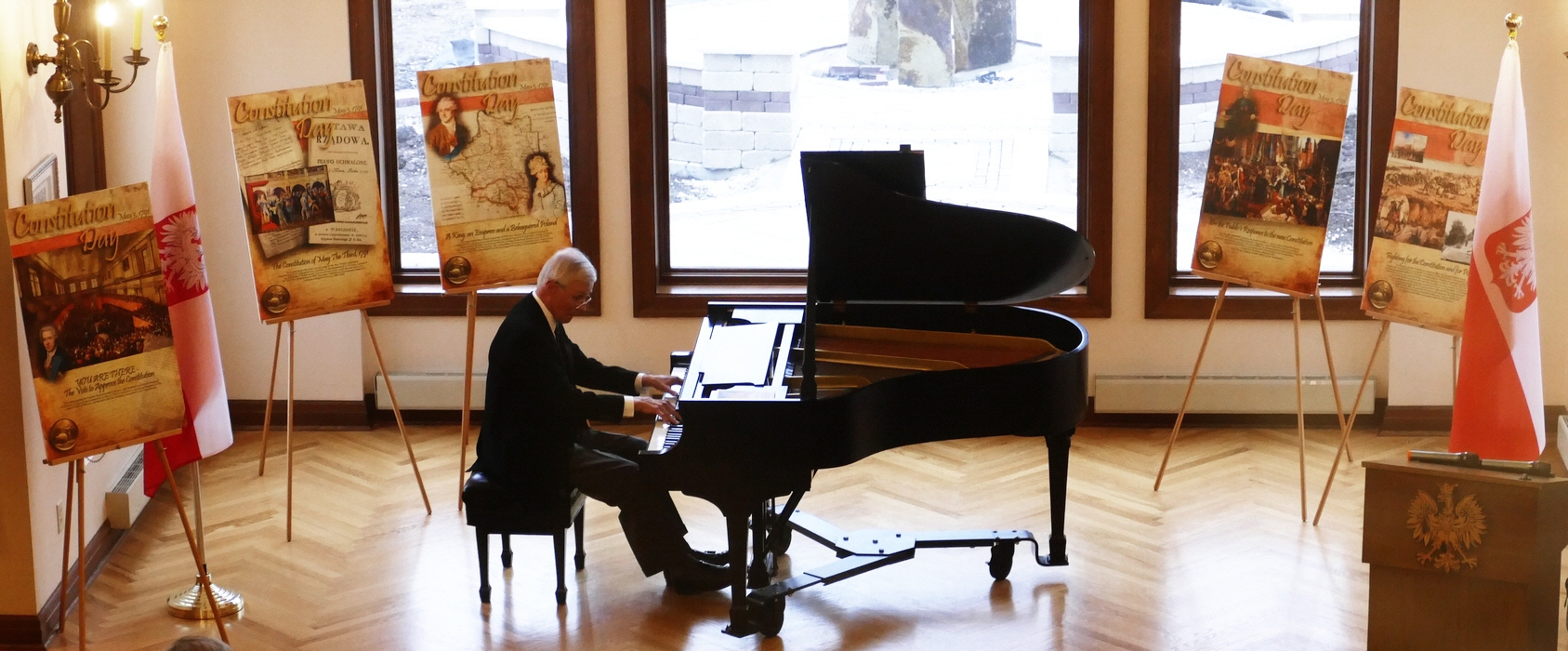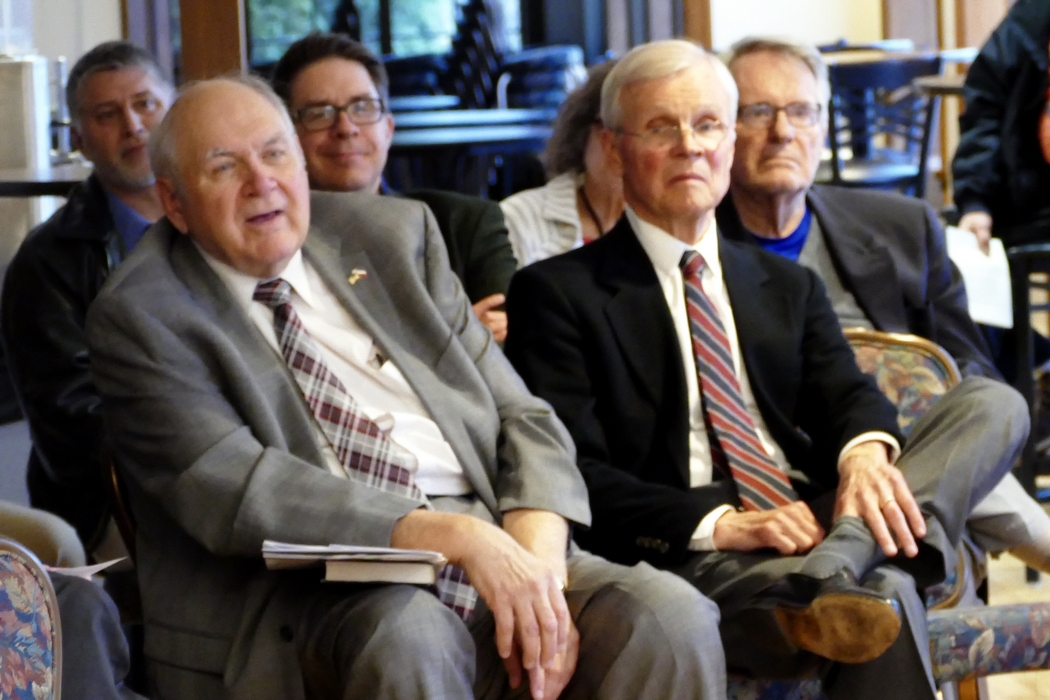Celebrating Constitution of May 3, 1791 in Polish Center of Wisconsin

2022 POLISH CONSTITUTION DAY
in Polish Center of Wisconsin
The 1791 Constitution was celebrated this year through Words, Music and Imagery. A series of five posters featuring the most iconic images related to the May 3rd Constitution provided a spectacular backdrop for the performance of Chopin’s music and remarks explaining the critical importance of this remarkable document.
The Hon. Francis T. Wasielewski was the pianist of the evening. A Judge of the Wisconsin Circuit Court for Milwaukee County for 28 years, he also pursues his life long love for music (studies at the University of Indiana School of Music and Wisconsin Conservatory of Music). He was President of the Polish Heritage Alliance of Wisconsin (2004 to 2009) and now sits on the Board of the Milwaukee Symphony Orchestra.
Chopin’s compositions played at the event:
Mazurka opus 6, No.3 in E major
Prelude opus 24, No. 4 in E minor
Prelude opus 24 No. 19 in E flat major
Grande Waltz Brilliante in E flat major opus 18
Etude opus 10 No. 3 in E major
Polonaise opus 40 No. 1 in A major
photo gallery
On the Significance of the Constitution and the Poster Exhibit
Remarks by Donald E. Pienkos
Professor Emeritus of Political Science
Tonight we celebrate an event that took place 231 years ago tomorrow, an event of great significance for Poland and for the cause of representative self government. It is the anniversary of the vote in Poland’s parliament that approved a new Constitution for the country. This Constitution, Europe’s first modern Constitution, is strikingly similar to our own Constitution that was ratified in 1789, just two years before.
Poland’s Constitution was indeed both remarkable – and critical to Poland’s very survival. It provided for a properly functioning parliament, an independent judiciary, and a strong executive. It created a permanent standing army to defend the country. At the same time the ‘May Third Constitution’ reaffirmed Poland’s tradition of religious toleration, respect for individual rights and the rule of law while declaring – for the very first time – that the country’s vast peasant population was part of the nation and under the government’s protection.
When the news of the Constitution came out, it won praise from freedom-loving people everywhere.
The Constitution reflected a concerted effort by patriotic Poles, including its reform-minded King, Stanislaus Poniatowski, to do away with the profound defects in its government that had left a once great country “in a perpetual state of near anarchy.” In doing so, they aimed at regaining Poland’s full independence in its dealings with the three giant powers on its borders – imperial Russia to the east, Habsburg Austria to the south, and German Prussia to the west.
 From left to right in the front row: Professor Donald Pienkos and Hon. Francis T. Wasielewski
From left to right in the front row: Professor Donald Pienkos and Hon. Francis T. Wasielewski
Indeed, less than twenty years before in 1772, those three superpowers, led by Empress Catherine II of Russia, had seized 30 percent of the country – a shocking act of aggression that our history books far too politely call “the first partition of Poland”.
But the new Constitution would last just 14 months. Some nobles, who in one historian’s words, held “views that epitomized the worst vices of the old Poland,” opposed its passage. Here, Catherine II took full advantage of their complaints by sending in a massive 100,000 man army to restore the old disorder.
Despite the heroic efforts by Poland’s vastly outnumbered forces, Russia and its Prussian ally prevailed in the war that followed. In 1793 they seized three-fifths of the country. Catherine then ordered a counterfeit Parliament to nullify the Constitution.
But only months later, Gen. Thaddeus Kosciuszko, who had served with distinction in our own War for Independence, led an insurrection to save Poland. But his last ditch effort was crushed. The three partitioners then divided up what little remained of the country. Poland would not regain its independence for 123 years – in 1918.
However, the memory of the Constitution did not die. As Mark Brzezinski, our new U.S. Ambassador to Poland, wrote in his book,The Struggle for Constitutionalism in Poland, its ideals inspired future generations of patriots. He cites one observer who declared, “The miracle of the Constitution did not save the Polish state. But it did save the Polish nation.” Indeed, after 1918 and again after 1989, the May Third Constitution has been celebrated as a great national day in independent Poland.
In closing let me note that in every country, there are moments that help define what its people stand for and aspire to be. For example, in our own America we have the Declaration of Independence of July 4, 1776 and Abraham Lincoln’s Gettysburg Address of 1863. In England there are Winston Churchill’s stirring words to rally the nation following the calamity of Dunkirk in 1940. In Poland there is the amazing election of June 4, 1989 that led to the collapse of communist rule and paved the way for the end of the Cold War. And there is the Constitution of May Third 1791.
Despite the heroic efforts by Poland’s vastly outnumbered forces, Russia and its Prussian ally prevailed in the war that followed. In 1793 they seized three-fifths of the country. Catherine then ordered a counterfeit Parliament to nullify the Constitution.
Now let me turn briefly to the Posters displayed tonite. The work of the Polish Center, they vividly tell the story of the Constitution and in various art forms.
The first shows what Poland looked like before and after the first partition of 1772. Poland’s king and the Empress of Russia, who were once young lovers, are pictured as they were in 1791 when they were much older.
The painting in the second panel is based on an eye witness drawing and shows the parliament at the moment of the vote to approve the Constitution. One of its authors is also shown.
The fourth panel portrays the joyous procession that followed the passage of the Constitution as conceived by the great Painter Jan Matejko. The king is at the left. Two of its authors are shown as well.
The final panel includes a fragment of Jan Styka’s painting of Kosciuszko’s victory over a large Russian army at Raclawice in April 1794. Together, nobles, townspeople, and peasants won that day – a high point in the fight for Poland. The monumental Raclawice Panorama is on permanent display today, inshrined in the city of Wroclaw.

This event was sponsored by The Milwaukee Society of the Polish National Alliance, in Cooperation with the Polish Center of Wisconsin and support from the Wisconsin Division of the Polish American Congress. Special Thanks for creating the Poster Exhibit go to Mr Jeff Kuderski, Executive Director of the Polish Center and Polish Fest, and Mr Jim Gaffney.
Archived Posts
- 80th Anniversary of the 1944 Warsaw Uprising
- 2024 Wianki Festival
- 2024 Polish Constitution Day in Wisconsin
- 2023 Merry Christmas
- 2023 Lighting the Light of Freedom on Dec 13 at 7:30pm
- Independence Day and Veteran Day invitation
- 2023 Wianki Festival
- 2023 May 3rd Constitution Day Celebration
- 2023 Lecture on Polish Borders by Prof. Don Pienkos
- 2023 REMEMBER THIS: Jan Karski movie premieres on PBS Wisconsin
- 2023 Upcoming lectures in the Polish Center of Wisconsin
- 2022 Polish National Independence Day
- 2022 Independence and Veteran Day Luncheon (invitation)
- 2022 Wianki, Polish Celebration of Noc Świętojańska (St. John’s Night)
- Celebrating Constitution of May 3, 1791 in Polish Center of Wisconsin
- 2022 Polish Constitution Day, Polish Flag Day and the Day of Polonia
- 2022 March Bulletin
- 2022 Polonia For Ukraine Donations
- 2022 Polish American Congress Condemns Russian Invasion of Ukraine
- 2022 PAC-WI State Division Letters to WI Senators and Representatives
- 2021 Polish Christmas Carols
- 2021 Panel Discussion: Martial Law in Poland 1981-1983 (REPORT)
- 2021 Panel Discussion: Martial Law. Poland 1981-1983 (invitation)
- 2021 Solidarity: Underground Publishing and Martial Law 1981-1983
- 2021 Polish Independence Day and Veterans Day
- 2021 Polish Independence Day and Veterans Day Luncheon
- 2021 Prof. Pienkos lecture: Polish Vote in US Presidential Elections
- 2021 POLISH HERITAGE MONTH EVENTS
- 2021 “Freedom” Monument Unveiled in Stevens Point, Wisconsin
- 2021 PCW Picnic and Fair
- 2021 Remembering Września Children Strikes (1901-1903)
- 2021 May 3 Constitution Day
- 2021 DYKP Contest Winners and Answers
- 2021 DYKP CONTEST EXTENDED and CASIMIR PULASKI DAY
- 2021 February announcements
- 2021 Polish Ministry of Education and Science oficials visit Wisconsin
- 2021 DYKP Contest, KF Gallery and Dr. Pease lectures
- 2020 Help Enact Resolution commemorating the 80th Anniversary of the Katyn Massacre
- 2020 Independence And Veterans Day
- 2020 Remembering Paderewski
- 2020 POLISH HERITAGE MONTH
- 2020 Solidarity born 40 years ago
- 2020 Battle of Warsaw Centenary
- 2020 The Warsaw Rising Remembrance
- 2020 June/July News: Polish Elections, Polish Films Online and more
- 2020 Poland: Virtual Tours
- Centennial of John Paul II’s Birth
- 2020 Celebrating Polish Flag, Polonia and Constitution of May 3rd
- 2020 Polish Easter Traditions
- 2020 Census and Annual Election
- Flavor of Poland (Update 3)
- 2020 Copernicus, Banach & Enigma talk
- 2020 Do You Know Poland and other announcements
- 2020 Flavor of Poland (Update 2)
- 2020 People and Events of the Year
- 2019 Holidays
- 2019 December Medley
- 2019 Independence Celebration
- 2019 Independence Invitation


